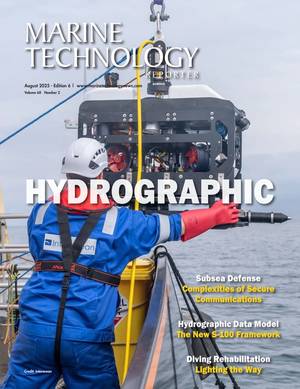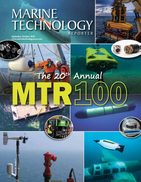
New Monitoring Platform Launched in Minas Passage
to the sea floor in the Minas Passage on Friday, February 2. “FORCE was created to explore whether in-stream tidal energy can be a safe, viable alternative to fossil fuel use, and help protect our ecosystem from the long term impacts of climate change,” said FORCE general manager Tony Wright. “As part of this exploration, it’s critical each turbine technology demonstrates it can co-exist with other uses of the Bay.” FAST-3 includes a suite of sensors to gather data on fish presence and behavior, including an acoustic zooplankton and fish profiler and an
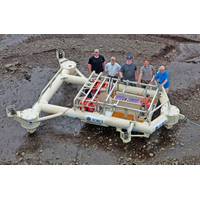
FORCE Uses ASL's Acoustic Zooplankton Fish Profiler
second. Understanding this powerful environment is critical to successful turbine design, environmental effects monitoring, and ultimately unlocking Fundy's enormous energy potential. “We need to understand what effects in-stream tidal technologies may have on the marine ecosystem,” said Tony Wright, general manager of FORCE. “If tidal energy is to grow to a larger scale, development must happen responsibly.” The AZFP instrument is an integral part of the Fundy Advanced Sensor Technology (FAST) project (Figure 1 & 2), discovering information about the presence and

New Site Data Collected for Fundy Tidal Project
Center for Energy (FORCE) working in concert with crew on the Dominion Victory have successfully recovered an underwater monitoring platform, known as FAST-1. “To explore the energy potential in the Bay of Fundy responsibly, we have to understand it,” said FORCE general manager Tony Wright. “We’re building a series of subsea instrument platforms that will give us a clearer picture of what’s happening at the FORCE test site.” The platform was retrieved in mid-July, and analysis of sensor data is now underway. Reliable site data is critical to all
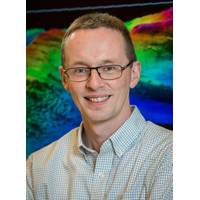
Seafloor Mapping Aids Safety & Efficiency
the sea floor has been critical to every decision we’ve made: where to lay power cables, where to locate turbines, how to operate safely, and where we can expect the most powerful currents. As the industry expands from single turbines into arrays, mapping will guide our way forward,” said Tony Wright, FORCE general manager. Clearwater Seafoods, a major international seafood company in Halifax, NS, has been using sea floor mapping to find marine habitat and create a more efficient and environmentally friendly fishery. Catherine Boyd, Clearwater’s manager, sustainability and public affairs

FORCE: Tidal Project Begins Construction on Subsea Platform
a clearer, moment-by-moment picture of the tidal currents at the FORCE site.” “The platform builds on the successful deployment last year of the first subsea cable ever laid in the Minas Passage - a task that proved we can work in the world’s most challenging tidal site,” said Tony Wright, GM, FORCE. The platform will be connected from sea to shore by a three km subsea data cable installed in 2013 and is expected to record vital information on the tides, current flow and water quality. It is part of FORCE’s Fundy Advanced Sensor Technology (FAST) program. The FAST program

Tidal Project Begins Construction on Subsea Platform
energy efforts. "To harness the enormous power of the Bay of Fundy, we have to understand it," said Mr. Melrose. "That's why we're building an underwater platform that will give us a clearer, moment-by-moment picture of the tidal currents at the FORCE site." Tony Wright, general manager of FORCE, said: "The platform builds on the successful deployment last year of the first subsea cable ever laid in the Minas Passage - a task that proved we can work in the world's most challenging tidal site." The platform will be connected from
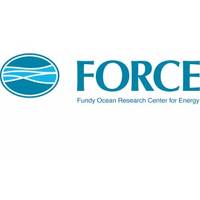
FORCE Expands Tidal Energy Project Team
efforts to harness the power of the highest tides in the world are accelerating this year, and more people are joining the project to help ensure its success. Today, speaking to industry, science, and government representatives at the Nova Scotia Energy Research and Development Forum, Tony Wright, general manager of FORCE (the Fundy Ocean Research Center for Energy), announced two new staff members and two new volunteer board members have joined the team to help realize the clean energy potential in the Bay of Fundy. "As we build on the success of installing the first-ever
New Technology Measures Tidal Speeds
height above the sea over long periods of time, beneficial to understanding turbine performance. “The Vectron gives turbine developers the first true understanding of the unique tidal regime they must design for, vastly improving their odds of successful and efficient operation,” said Tony Wright, director of marine operations at FORCE, to a gathering of industry, government and scientific representatives at a conference hosted by Marine Renewables Canada in Ottawa. Wright added, “The Vectron also meets a need for more accurate, site-specific data at high flow sites worldwide

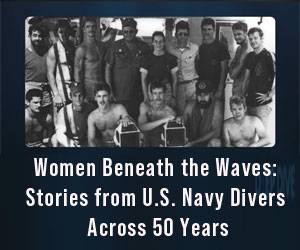

 August 2025
August 2025
